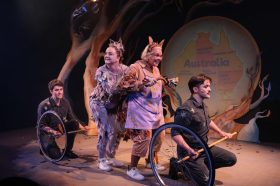There has been an explosion in crowdfunding over the last few years, especially in the creative industries, with many crowdfunding platforms proliferating including Indiegogo and Kickstarter. The Australian platform, Pozible, was launched in January 2011 (first badged as Fundbreak in May 2010) and is listed in Wikipedia ‘as a crowdfunding platform and community-building tool for creative projects and ideas. It was developed to help people raise funds, realise their aspirations and make great things possible’.
According to Rick Chen, co-founder of Pozible, film and music are the two most popular and successful types of projects for crowdfunding. He emphasises that a crowdfunding campaign is just as much about building an audience and creating an online community for your film as it is about raising the cash. Hold that thought as this is what ultimately makes the difference to the all-consuming task of crowdfunding.
For those you haven’t yet experienced the joys of crowdfunding, the basic idea is that you set a financial target and a time limit, create a range of non-financial rewards for your supporters and then start contacting everyone you know and as many people as possible you don’t know through social media. With most crowdfunding platforms, including Pozible, you have to reach your target within the timeframe or you don’t receive any of the money pledged. Sounds simple, doesn’t it?
I spoke to Annmaree Bell (producer) and Craig Boreham (writer/director) who are currently crowdfunding for Craig’s debut feature film, Teenage Kicks. They are aiming to raise $67,000 in 67 days to plug the gap in their finance plan. When I asked Annmaree how it was going, she commented that crowdfunding was more stressful than making the film.
Bell and Boreham did a lot of research beforehand and took several months to prepare their campaign strategy and online assets, including setting up a Facebook page for the film, Twitter, Tumblr and Instagram accounts and Craig’s blog. They are posting new content every day and have been careful to keep the Teenage Kicks Facebook page focussed on building their teenage film audience while their Pozible campaign has focussed on raising funds from a wider audience.
I also spoke to Miranda Edmonds in Western Australia who has recently participated in Screen West’s crowdfunding initiative 3 to1, a crowdfunding partnership between ScreenWest and Pozible where ScreenWest contributes triple the funds to those raised through crowdfunding. Initially, ScreenWest selected 27 projects and, out of these, 14 projects reached their financial targets through their Pozible campaigns. The first six projects to reach their target were funded from the fixed pool of funds on a first-in first-served basis until the funds were exhausted. ScreenWest is planning another round of 3 to1 in the near future. This scheme certainly makes crowdfunding an even more attractive and incentivised option for filmmakers. Let’s hope the other state screen agencies take note.
Edmonds is one of the directors (with her brother, Khrob) of the deliciously titled short film, Tango Underpants, written by John Collee, starring Emma Booth – with the tasty title supplied by Tania Chambers. Tango Underpants was the first project to raise their target of $25,000 which took just 24 hours. Through 3 to 1, with an additional $7,000 raised through crowdfunding, they have increased their budget to $107,004.
But behind the scenes, Edmonds says it was a huge team effort. Producers Tania Chambers and Stephen Van Mil, publicist and associate producer Estelle Buzzard and social media expert Maya Kavanagh all hit the phones and the web en masse for 48 hours. She did admit that Maya had to sit the team down and explain how to use Tumblr and Instagram.
The deadline and pressure of a limited pool of funds from Screen West provided the impetus and urgency essential to being able to raise their target within 24 hours. Edmonds noted that just before the 24 hours was up, and knowing the other projects were racing towards their target, they put out a final call to all their supporters who generously dug deep and pushed their project first over the line.
Both the Teenage Kicks and Tango Underpants teams had long lead times for their campaigns, filming the Pozible trailer, video content and interviews in the months before their launch.
With The Gift, we filmed a series of clips with the director, Lucy Gaffy, before we started the film shoot and have been posting them throughout the campaign, which ended successfully on May 3rd, three days before the official cut-off.
We found that we needed a whole separate team of videographer, two editors and the absolutely essential young social-media-savvy networker to create and manage the content and ongoing uploading, posting and monitoring required to keep the social media machine constantly chattering. Edmonds and Bell both have young social media experts working on their teams, with Kavanagh slated to travel to South America with the Tango Underpants crew for the sole purpose of filming and uploading short clips and photos daily on her iPhone and managing the social media during the shoot.
The social media team becomes another cost to film production. On a short film like ours, we recruited volunteers but on a larger project they become part of the paid crew. As crowdfunding becomes more mainstream, which, according to Chen it is rapidly doing so, the business of crowdfunding becomes more commercial. The Veronica Mars crowdfunding campaign on Kickstarter broke all records in the website’s history – the fastest project to reach both $US1M and $US2M (in 24 hours) and the all-time highest funded movie project at $US5.7M with 91,585 supporters. The star of the hit TV series, Kristen Bell, and the series creator, Rob Thomas, fronted the campaign that galvanised the huge built-in audience from the TV series who wanted to support the production of a feature film.
Rick Chen says it is likely that there was a huge professional publicity machine behind the Veronica Mars campaign and that this is probably beyond the reach of the majority of film projects in Australia.
The length of the campaign is another factor we considered. Chen recommends the shorter the better, with 30 days being a great length. The Teenage Kicks campaign is running for 67 days (ending on 26 May) and The Gift for 60 days and we have all noticed there is a definite slump in pledges and energy in the middle part – or second act – of the campaign. With the third act climax approaching, I felt the urgency of the deadline exerting its magic and I found myself constantly refreshing my Pozible page on my desktop as I tracked every pledge throughout every day. It was a long week, even though we were confident we would reach our target. However, if I do this again, I would definitely take Chen’s advice and run a shorter campaign. The power of a deadline, backed up by an intense social media blitz, was well demonstrated in both the Tango Underpants and Veronica Mars campaigns and I now appreciate ‘the shorter the better’ maxim.
One of the other keys to crowdfunding and building your online audience is the profile and fan base of the lead actor(s). This worked well for Tango Underpants with Emma Booth starring in the lead role. Emma was the online face of the film and she has a strong local and international profile. In Teenage Kicks, Miles Szanto, who plays the lead (Love My Way and The Elephant Princess), is active online with his own blog supporting the film from America. With Teenage Kicks, Bell found fan blogs have created a strong response from their young audience, including fans from their earlier short film, Drowning which starred Xavier Samuel. Well-known cast with their own fan base provide great leverage online and help the project stand out in the crowded world of social media.
So who supports these projects? Rick Chen says that of course family and friends should be the first people to come on board to support your project. That’s certainly my experience with The Gift where I would estimate about 80% of our supporters are family, friends and personal contacts. Bell report a similar proportion so far with their Teenage Kicks campaign. Edmonds felt that it was 50% friends and family plus the Australian film community getting strongly behind the project.
When Stephen Van Mil did an interview on the local ABC radio station, Edmonds reports they saw an immediate spike in their pledges. There was one supporter from Uruguay (the film is set in South America), living in Australia, who heard the interview and loved the idea for the film. He came on board first an investor and now an executive producer and says he has already got his money’s worth – and they haven’t started filming yet. And even better – he had never been involved in film before. That is the gold in crowdfunding – to reach beyond your known world and build an audience outside your usual networks.
An ongoing issue in crowdfunding campaigns is how often to contact your friends, family, colleagues and potential supporters throughout the campaign. Obviously this is very dependent on the project and the team, however, if your campaign runs longer than 24 hours, it is an ongoing discussion you will be having throughout the life of the campaign. All bets are off in the last few days when your target is so close and you can find yourself throwing all your previous social niceties to the wind and bombarding everyone you have ever known until the gong rings.
This is where expanding your supporters and audience becomes vital – how many times will mum, dad and your mates chip into your film projects? And of course, it’s equally important to hold onto your audience so they can continue to support your future projects. The Facebook page you set up for your film becomes the conduit to your audience and this needs to be constantly maintained and updated throughout the whole production and post production process until your film is released, and thereafter.
Producers, directors and actors alike are building their social media muscles to ensure they take their audience with them on their next film and they do that from as early as possible in the life of the film. If there is only one thing you learn from crowdfunding it’s that you do not ever want to start from a low or close to zero support base again. Wonderfully, after all this work, when you do release your film you have a carefully nurtured audience hungry to see it.
You definitely need a comprehensive strategy and the social media team being across all aspects of the film and understanding the voice, tone and public face of the film is essential. In a film like Teenage Kicks which deals with youth alienation, both Bell and Boreham are very sensitive to their young audience and make sure they invite user-generated content to be sent to them directly so they can monitor it before it is posted onto their social media platforms.
For The Gift we had Odd Studios, a well known prosthetics house, build a ‘beast’ for the film and, although we filmed some behind-the-scenes material of the concept work and the building and fitting of the beast costume, we have been careful not to share images of the complete beast until the film is launched.
As crowdfunding becomes more popular and more mainstream – Chen predicts fashion, sport and social enterprise, not-for-profit organisations as growth areas, the users of crowdfunding will become more professional and experienced. Rick Chen reports that Pozible is further developing the model with increased functionality and more tools plus using tax-deductible receipts to make the model more accessible.
Crowdfunding is a bit like child birth – you can read up and research it, prepare well for the event, talk to lots of other people who have gone through the same experience but no matter what anyone else tells you and no matter how much you prepare, you have to go through it yourself to truly appreciate the effort and rewards involved. Would I crowd fund again? Let’s just say, I have two children and many more film projects.
For more information, check out the Pozible campaigns for Teenage Kicks and The Gift , and the websites for Tango Underpants, ScreenWest and Pozible. Pozible run regular monthly information seminars on crowdfunding at their Melbourne and Sydney offices, so check out their website for dates.





